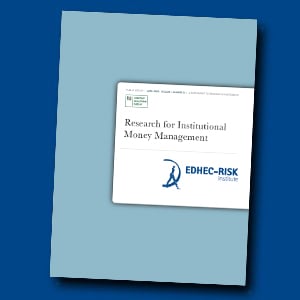
P&I EDHEC Research for Institutional Money Management April 2020
Written on 14 Apr 2020.
EDHEC-Risk Institute just published the latest special issue of the EDHEC Research for Institutional Money Management supplement to Pensions & Investments.
We aim to provide institutional investors with an academic research perspective on the most relevant issues in the industry today.
In the first article, Professor Gianfranco Gianfrate discusses how the latest evidence about the magnitude of climate change risks demands faster and more decisive actions to mitigate the exposure of financial intermediaries and investors – and, as a consequence, of the real economy. There is a clear need to unleash financial engineering to manage climate risks. The role of financial markets and financial innovation as a mechanism to enforce climate policy and to accelerate the transition toward a low-carbon economy is still overlooked.
Our second article proposes a definition of value in Treasury bonds that allows for statistically significant and economically relevant predictions of cross-sectional excess returns. The value pricing factor exploits the differences between the market and theoretical values of Treasury bonds assessed using an economically justifiable Gaussian dynamic term structure model. A long-only version of the value strategy outperforms the market portfolio in terms of Sharpe ratio in 14 of the 15 three-year periods considered
Our third article proposes a definition of value in Treasury bonds that allows for statistically significant and economically relevant predictions of cross-sectional excess returns. The value pricing factor exploits the differences between the market and theoretical values of Treasury bonds assessed using an economically justifiable Gaussian dynamic term structure model. A long-only version of the value strategy outperforms the market portfolio in terms of Sharpe ratio in 14 of the 15 three-year periods considered.
While factor investing and liability-driven investing relate to two separate strands of the academic literature, a strong case can be made for combining these approaches. Each of the three steps of a liability-driven investing process, namely the construction of a well-rewarded performance-seeking portfolio, the construction of a safe liability-hedging portfolio and an efficient allocation to these building blocks, can be better addressed by taking a factor perspective. Our third article can be regarded as a first step toward the introduction of a comprehensive investment framework blending liability-driven investing and factor investing.
We introduce a method to create two interpretable liquidity measures, which we associate with market and funding liquidity. This involves creating two parsimonious linear combinations of the many liquidity proxies often used in the liquidity literature. Our construction does not require transaction-level data (such as volume or bid-offer spreads), but correlates well both with other measures that do, and with other liquidity proxies (liquidity as “noise,” liquidity as broker-dealer leverage) recently introduced in the literature.
Finally, we examine the question of cross-sectional momentum in the U.S. sovereign bond market. We show that long-short duration-adjusted cross-sectional reversal strategies are significantly profitable over an extended range of lags and illustrate a possible application of this result in a long-only framework. We link the profitability to two factors: (i) the ability of the duration-adjustment procedure to single out winners and losers through their exposure to slope changes, and (ii) the degree of mean-reversion of the slope.
The latest issue of the EDHEC Research for Institutional Money Management supplement to P&I proposes the following articles:
- A Look at the Landscape for Climate Change Finance
- Defining and Exploiting Value in U.S. Treasury Bonds
- Factor Investing in Liability-Driven Investment Solutions
- Robust and Interpretable Liquidity Proxies for Market and Funding Liquidity
- Cross-Sectional Momentum in the U.S. Sovereign Bond Market
Related link:
P&I EDHEC Research for Institutional Money Management April 2020


